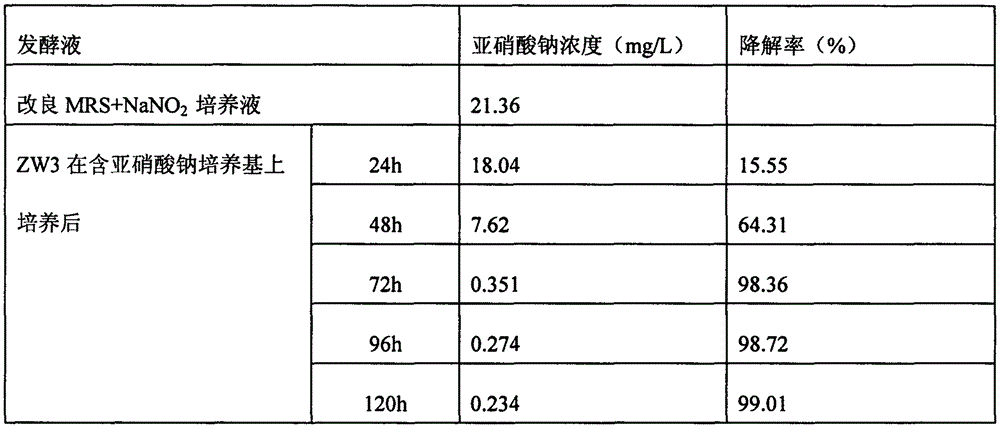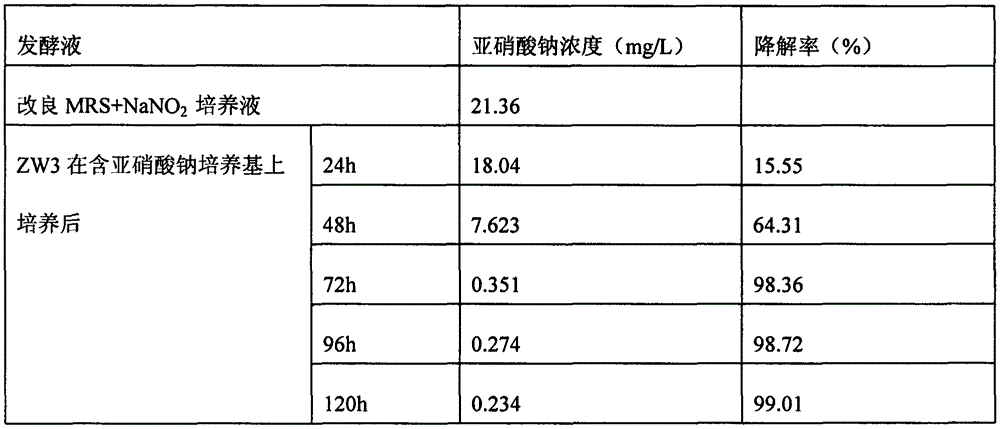Koumiss sample lactobacillus ZW3 with efficient nitrite degrading function and application of koumiss sample lactobacillus ZW3
A technology of nitrite and kumiss, applied in the field of sour beans, can solve the problems of slow growth, inconspicuous fermentation characteristics, inferior flavor to natural fermentation, etc., and achieve the effect of increasing value
- Summary
- Abstract
- Description
- Claims
- Application Information
AI Technical Summary
Problems solved by technology
Method used
Image
Examples
Embodiment approach 1
[0031] In the present embodiment, select no rotten beans, remove the stalks, wash, and dry. After entering the altar, add pepper and garlic to enhance the flavor, pepper to enhance the fragrance, and insert 8% (v / v) of newly activated Starter, the starter is a mixture of Leuconostoc enterococci, Lactobacillus plantarum, and Lactobacillus kumissi with a ratio of 1:1:2, adding 4% (w / v) salt, 2% (w / v) sucrose, Ferment at a constant temperature of about 25°C for 5 days to obtain sour bean kimchi.
[0032] The uninoculated raw materials were marinated at about 25°C for a comparative test.
[0033] Described above-mentioned bacterial classification adopts following method to cultivate and obtains:
[0034] First, activate the strains, inoculate Leuconostoc enterococci and Lactobacillus plantarum refrigerated at -80°C in MRS liquid culture medium, and culture them at 37±1°C for 24 hours, and inoculate Lactobacillus kumissi ZW3 in improved MRS liquid culture medium culture medium at...
Embodiment approach 2
[0041] In the present embodiment, select no rotten beans, remove the stalks, wash, and dry. After entering the altar, add pepper and garlic to enhance the taste, pepper to enhance the fragrance, and insert 7% (v / v) of newly activated Starter, the starter is a mixture of Leuconostoc enterococci, Lactobacillus plantarum and Lactobacillus kumissi with a ratio of 1:1:1, adding 3% (w / v) salt, 2% (w / v) sucrose, Ferment at a constant temperature of about 25°C for 6 days to obtain sour bean kimchi.
[0042] The uninoculated raw materials were marinated at about 25°C for a comparative test.
[0043] After the fermentation was completed, the pH, acidity (calculated as lactic acid) and nitrite content of the capers were measured. The results obtained are as follows:
[0044] Use of leavening agent
[0045] Leuconostoc enterococci:Lactobacillus plantarum:Lactobacillus kumissi=1:1:1
Embodiment approach 3
[0047] In the present embodiment, select no rotten beans, remove the stalks, wash, and dry. After entering the altar, add pepper and garlic to enhance the taste, pepper to enhance the fragrance, and insert 7% (v / v) of newly activated Starter, the starter is a mixture of Leuconostoc enterococci, Lactobacillus plantarum, and Lactobacillus kumissi with a ratio of 2:1:1, adding 3% (w / v) salt, 2% (w / v) sucrose, Ferment at a constant temperature of about 25°C for 6 days to obtain sour bean kimchi.
[0048] The uninoculated raw materials were marinated at about 25°C for a comparative test.
[0049] After the fermentation was completed, the pH, acidity (calculated as lactic acid) and nitrite content of the capers were measured. The results obtained are as follows:
[0050] edible starter
[0051] The bacterium is compounded with other lactic acid bacteria for the fermentation of cowpea, and the nitrite content of the obtained capers is all lower than 0.3 mg / kg, which is far ...
PUM
 Login to View More
Login to View More Abstract
Description
Claims
Application Information
 Login to View More
Login to View More - R&D
- Intellectual Property
- Life Sciences
- Materials
- Tech Scout
- Unparalleled Data Quality
- Higher Quality Content
- 60% Fewer Hallucinations
Browse by: Latest US Patents, China's latest patents, Technical Efficacy Thesaurus, Application Domain, Technology Topic, Popular Technical Reports.
© 2025 PatSnap. All rights reserved.Legal|Privacy policy|Modern Slavery Act Transparency Statement|Sitemap|About US| Contact US: help@patsnap.com


